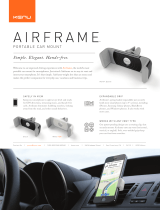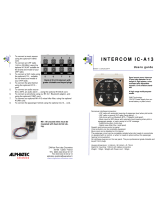Table of Contents
SECTION I GENERAL INFORMATION ......................................................................................................... 1-1
1.1 INTRODUCTION ............................................................................................................................................. 1-1
1.2 SCOPE ............................................................................................................................................................... 1-1
1.3 EQUIPMENT DESCRIPTION ........................................................................................................................ 1-1
1.4 APPROVAL BASIS - ........................................................................................................................................ 1-2
1.5 SPECIFICATIONS ........................................................................................................................................... 1-2
1.6 EQUIPMENT SUPPLIED ................................................................................................................................ 1-3
1.7 EQUIPMENT REQUIRED BUT NOT SUPPLIED ....................................................................................... 1-4
1.8 LICENSE REQUIREMENTS .......................................................................................................................... 1-4
SECTION II - INSTALLATION ......................................................................................................................... 2-1
2.1 GENERAL INFORMATION........................................................................................................................... 2-1
2.1.1 SCOPE ............................................................................................................................................................ 2-1
2.1.2 UNPACKING AND PRELIMINARY INSPECTION ..................................................................................................... 2-1
2.2 SYSTEM CONFIGURATION ................................................................................................................................... 2-1
2.2.1 DISASSEMBLY AND ACCESS ............................................................................................................................... 2-1
2.2.2 SINGLE/DUAL CONFIGURATION JUMPERS J4 & J5 .............................................................................................. 2-3
2.2.3 DIP SWITCH CONFIGURATIONS ......................................................................................................................... 2-4
2.2.4 PASSENGER AND EXPANSION DIP SWITCH CONFIGURATIONS ............................................................................ 2-4
2.2.5 DIP SWITCH CROSS REFERENCE. ....................................................................................................................... 2-6
2.3 EQUIPMENT INSTALLATION PROCEDURES .......................................................................................................... 2-8
2.3.1 MOUNTING REQUIREMENTS .............................................................................................................................. 2-8
2.3.2 COOLING REQUIREMENTS ................................................................................................................................. 2-9
2.3.3 MOUNTING RACK INSTALLATION ...................................................................................................................... 2-9
2.3.4 TRAY AND CONNECTOR ASSEMBLY .................................................................................................................. 2-9
2.4 CABLE HARNESS WIRING ................................................................................................................................... 2-9
2.4.1 NOISE ............................................................................................................................................................... 2-9
2.4.2 EXISTING KMA 24H INSTALLATION ............................................................................................................... 2-10
2.4.3 POWER ........................................................................................................................................................... 2-10
2.4.4 COMMUNICATIONS PUSH-TO-TALK (SINGLE PANEL INSTALLATION) ................................................................. 2-10
2.4.5 AUDIO PANEL INTERFACE ............................................................................................................................... 2-10
2.4.6 TRANSMIT INTERLOCK .................................................................................................................................... 2-10
2.4.7 "SWAP" MODE ................................................................................................................................................ 2-11
2.4.8 BACKLIGHTING ............................................................................................................................................... 2-11
2.4.9 UNSWITCHED INPUTS ...................................................................................................................................... 2-11
2.4.10 PA MUTE (J3, PIN 8) .................................................................................................................................... 2-11
2.4.11 PUBLIC ADDRESS (J3, PIN B) ........................................................................................................................ 2-11
2.4.12 INTERCOM WIRING ........................................................................................................................................ 2-11
2.4.13 ENTERTAINMENT INPUT (J3 PIN 7) ................................................................................................................ 2-12
2.4.14 INTERCOM EXPANSION (P/N 11606 OR 11606R) ........................................................................................... 2-12
2.4.15 CVR OUTPUT............................................................................................................................................... 2-13
2.5 ADJUSTMENTS ................................................................................................................................................... 2-13
2.6 COMMUNICATIONS ANTENNA INSTALLATION NOTES ...................................................................................... 2-13
2.7 TELECOMMUNICATIONS INTERFACE ................................................................................................................. 2-14
2.8 PAC24 PIN ASSIGNMENTS ................................................................................................................................ 2-15
2.9 POST INSTALLATION CHECKOUT ...................................................................................................................... 2-16
2.10 UNIT INSTALLATION ....................................................................................................................................... 2-16
2.10.1 OPERATIONAL CHECKOUT ............................................................................................................................ 2-16
2.11 FINAL INSPECTION ......................................................................................................................................... 2-17
SECTION III OPERATION ................................................................................................................................ 3-1
3.1 SCOPE ............................................................................................................................................................... 3-1
3.2 PAC24 CONTROLS ............................................................................................................................................. 3-1
3.3 POWER SWITCH (3) (EMG-FAIL SAFE OPERATION) .......................................................................................... 3-1
3.3.1 SINGLE PANEL FAIL SAFE OPERATION .............................................................................................................. 3-1
3.3.2 DUAL PANEL FAIL SAFE OPERATION ................................................................................................................. 3-1
3.4 COMMUNICATIONS SELECTION (2) ..................................................................................................................... 3-2
3.4.1 TELEPHONE OPERATION (S5 SWITCH 4 SELECTED ON) ...................................................................................... 3-2
3.4.2 STUCK MICROPHONE PROTECTION .................................................................................................................... 3-2





















